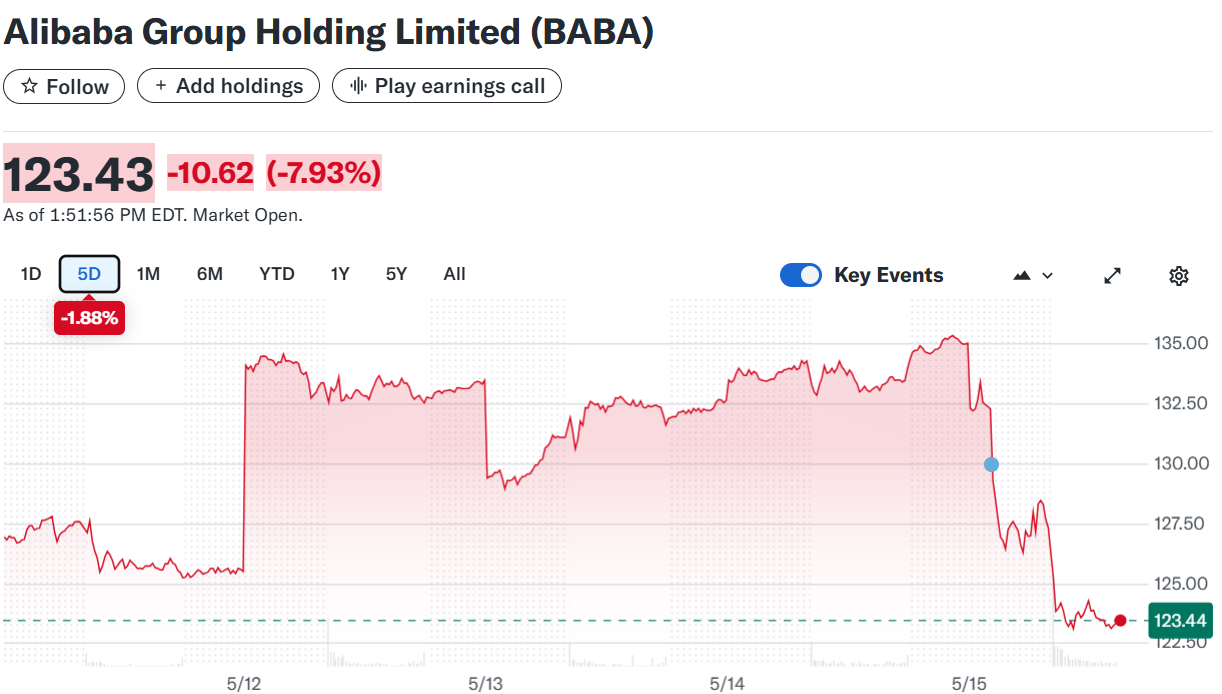TLDR
- Alibaba missed Q4 revenue and profit estimates despite 7% year-on-year revenue growth.
- Net income rose 279% YoY but was far below analyst forecasts.
- The stock dropped over 8% following the results.
- Taobao and Tmall posted 9% growth, with customer management revenue up 12%.
- Cloud and AI businesses showed robust growth amid intense domestic competition.
Alibaba Group Holding Ltd. (NYSE: BABA) reported weaker-than-expected fiscal fourth-quarter earnings on May 15, 2025. Shares fell over 8% after the company posted revenue of 236.5 billion yuan ($32.6 billion), slightly below the 237.2 billion yuan expected. Net income came in at 12.4 billion yuan ($1.71 billion), missing forecasts of 24.7 billion yuan.

Alibaba Group Holding Limited (BABA)
The disappointing results came despite a 7% year-over-year rise in revenue and a 279% increase in net income, which was off a low base. The earnings report halted Alibaba’s impressive 2025 rally, which had seen the stock climb nearly 60% year-to-date, amid optimism around China’s stimulus-driven economic recovery.
Macroeconomic Uncertainty and Competitive Pressures
The earnings miss highlighted Alibaba’s ongoing challenges, including weak consumer sentiment and macroeconomic volatility in China. Although Beijing and Washington agreed to suspend most trade tariffs in April, the damage from the earlier trade war continues to impact confidence.
Competition remains fierce. JD.com and PDD Holdings, parent of Temu, are aggressively pushing promotions, sparking a price war. While JD.com reported better-than-expected results earlier this week, Alibaba is navigating a more complex terrain with intensifying rivalry across major platforms.
E-commerce Growth Still Evident
Despite the macro headwinds, Alibaba’s domestic e-commerce platforms performed solidly. The Taobao and Tmall Group recorded a 9% rise in revenue to 101.4 billion yuan. Customer management revenue, driven by merchant services, rose 12%, showing some resilience.
To attract more consumers, Alibaba extended its partnership with Rednote (Xiaohongshu), allowing users to click Taobao links embedded in social media posts. Management also announced aggressive investment into an “instant commerce” feature, promising one-hour delivery in select Chinese markets.
Cloud and AI Growth Gains Momentum
Alibaba’s cloud segment delivered strong results, with revenue climbing 18% year-over-year to 30.1 billion yuan. Growth was driven by AI product adoption and public cloud expansion. CEO Eddie Wu noted that AI-related product revenue saw triple-digit growth for the seventh consecutive quarter.
In April, Alibaba launched Qwen 3, the latest version of its open-source large language model powering its AI assistant, Quark. Wu told investors during the earnings call that the company sees “significant growth” in cloud AI services over the coming quarters.
Valuation Outlook
Despite the earnings miss, analyst sentiment remains moderately optimistic. The average one-year price target from 38 analysts is $161.06, suggesting over 20% upside from current levels. However, GuruFocus pegs its intrinsic value at $110.22, implying a potential 17.8% downside.
With strong YTD and 1-year returns, Alibaba remains a focal point in Chinese tech, though future performance will depend heavily on consumer recovery, competition, and continued cloud momentum.






